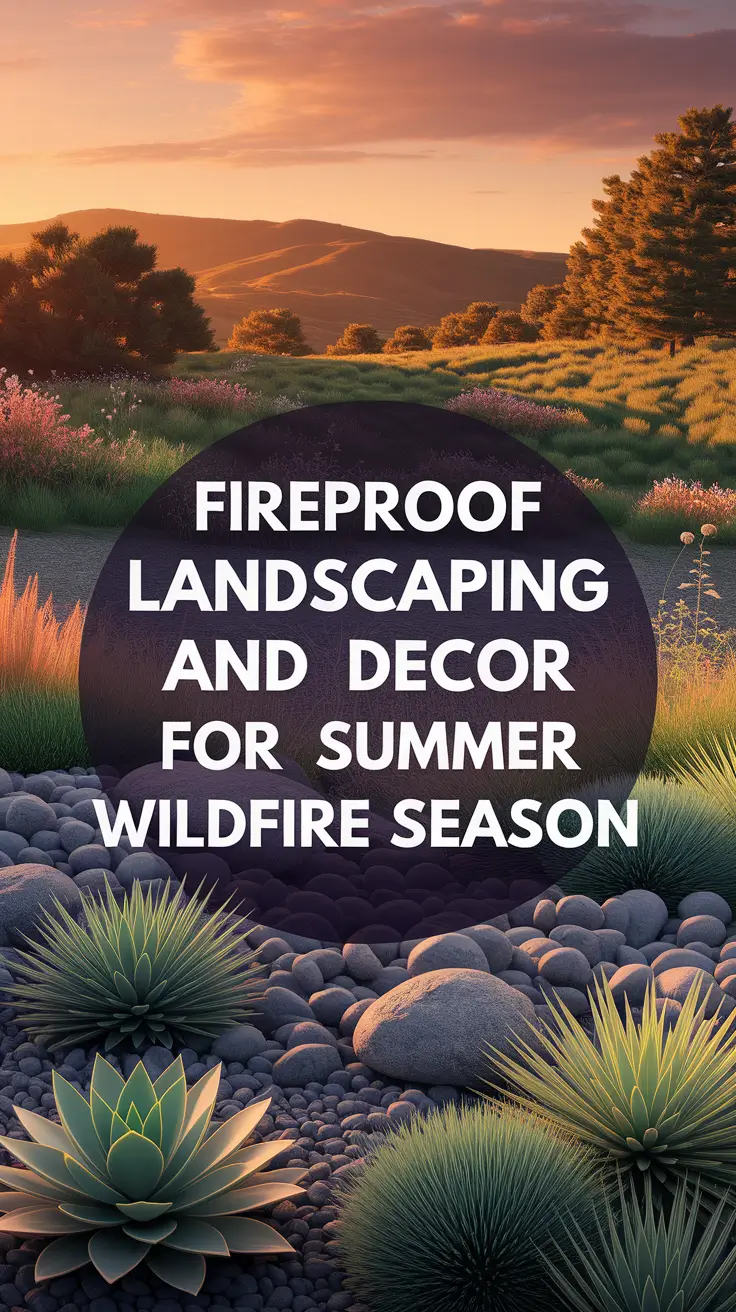Fireproof Landscaping and Decor for Summer Wildfire Season

Have you ever stood out in your backyard and thought: could this space actually protect me in a fire?
That was the question that slapped me in the face one hot July afternoon. The heat was thick, the air dry, and somewhere off in the distance, a helicopter droned low over the hills. A brushfire had sparked miles away—and suddenly, I couldn’t stop scanning my patio for kindling.
If you’ve ever lived through a dry summer in the West or South, you know the creeping anxiety that comes with wildfire season. It’s not about fear-mongering—it’s about being prepared. And surprisingly, that preparation can be beautiful.
In this post, I’m sharing exactly how I reimagined my outdoor space to be both welcoming and wildfire-smart. From plant choices to patio furniture, here’s what worked, what I changed, and what you can absolutely do too.

Why Fireproof Landscaping Isn’t About Fear—It’s About Control
Here’s the part I didn’t expect: fire-safe landscaping doesn’t mean sacrificing style. For a long time, I thought “fireproof” meant sterile, gray gravel and boring succulents. Turns out, it just means thinking ahead.
Wildfires become more intense and more frequent, in particular, in areas that used to be low-risk. If you’re in California, Arizona, or even some of the areas of Texas and Colorado, smart design now incorporates firewise planning. It’s not panic. It’s just part of the plan.
Knowing that your space is designed to slow down the spread of a fire? That’s peace of mind you can really have – especially when it looks this good.
The 3-Zone Rule That Changed Everything
Here is how that worked out for me.
I learned about the “Defensible Space” concept from a local fire prevention officer. It divides your property into three zones, depending on the distance from your home, and it’s genius.
1. The Immediate Zone (0–5 feet)
This is your first line of defense. For me, this meant:
- Removing bark mulch and replacing it with decomposed granite
- Moving my potted plants away from the walls
- Swapping out wicker chairs for powder-coated metal
2. The Intermediate Zone (5–30 feet)
This zone is where flames might jump. I:
- Planted low-water, high-moisture plants like yarrow and sedum
- Broke up flower beds with stone borders
- Installed a drip irrigation system to ensure that the roots are not soggy but hydrated.
3. The Extended Zone (30+ feet)
This zone is where you slow down the fire’s approach:
- We cleared dead tree limbs and brush
- Kept the lawn short and well-spaced
- Stored firewood in a bin far from the house
It was empowering to use our yard as a soft armor. Not invincible. But intelligent.
What to Look For in Fire-Resistant Plants
It began with a visit to the nursery, and an ever so awkward conversation.
“Do you have any plants that won’t burn?” I asked, half-joking.
Turns out, yes. There are plants that are naturally fire-resistant due to the fact that they have more water, thicker leaves or they do not contain flammable oils.
What Worked Best in My Yard:
- Agave and aloe: Bold shapes, very little water needed
- Lavender (yes!): But only in moderation, and spaced out
- Sedum and ice plant: Hardy ground covers with juicy leaves
- Yarrow: Soft, fern-like leaves and long bloom cycles

What I Avoid Now:
- Resin-heavy evergreens like juniper
- Tall ornamental grasses that dry out fast
- Anything eucalyptus (sadly beautiful but a fire risk)
These changes brought texture and softness—without compromising safety.
Cozy, But Fire-Smart: My Outdoor Lounge Reboot
This is where it all shifted. I had a Pinterest perfect patio, complete with candles, fairy lights, and weathered wood. But all those pretty pieces? Fire hazards.
Therefore I redesigned while having fire safety and visual warmth in mind.
Now, I still light the space in the evenings. But I use enclosed lanterns with solar-powered bulbs. They are as dreamy and I don’t have to worry about embers catching.
Smart Decor Swaps That Still Feel Like You
I was afraid going “fireproof” meant going cold. However, here are some of my favorite decorative swaps that made me wrong:
- Gravel instead of bark mulch: Chic, crunchy, and doesn’t smolder
- Metal wall decor: Looks artisan, won’t ignite
- Stone sculptures: Earthy and grounding
- Clay wind chimes: Gentle sound, no risk
- Fire glass instead of wood: In gas fire pits, it’s stunning and safer
Sometimes the safest options are also the most elegant.
Maintaining Fire-Smart Landscaping Without Burnout
Here’s the deal: fire-resilient yards are lower-maintenance in the long run.
After I made the big changes, maintenance was even easier. Here’s my go-to checklist:
- Weekly: Blow away dry leaves and debris
- Bi-weekly: Check drip lines and hose timers
- Monthly: Trim dead branches and check mulch zones
I use a shared Google Calendar to set reminders. It is one of those little things that make you feel that you are more in control of your space – and your peace of mind.
Final Thoughts
I never thought that fireproof landscaping will make my summer more joyful. But it has. My yard is still blooming, my evenings are warm, and I know that I am doing all that I can to protect my home.
It doesn’t take huge changes. Just thoughtful ones.
Do you think you would try some of these swaps in your yard?
Pin this if you’re planning a summer home refresh
And tell me – what is one little thing that gave you more peace this year?

